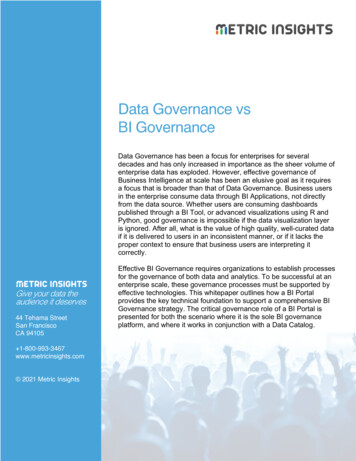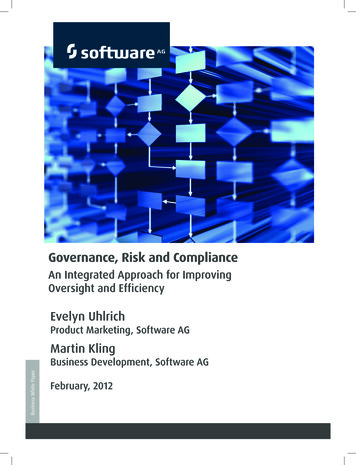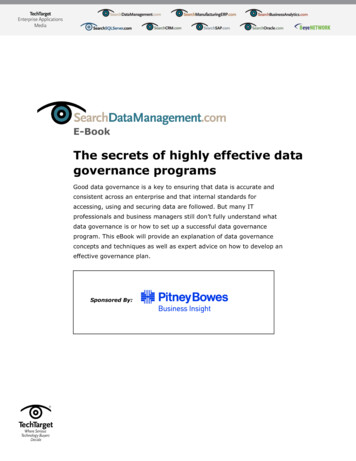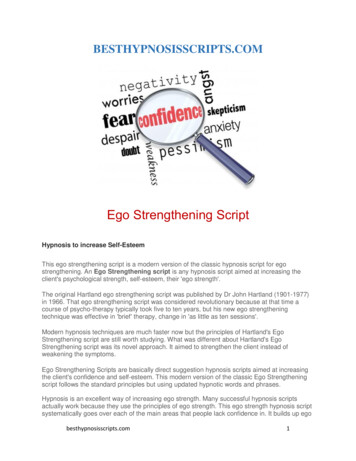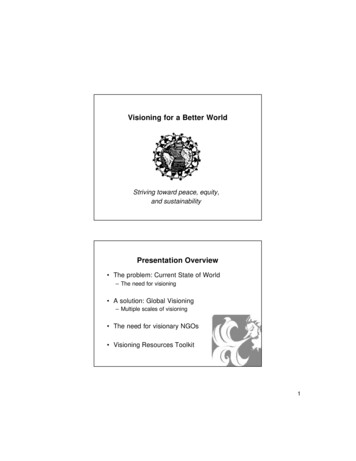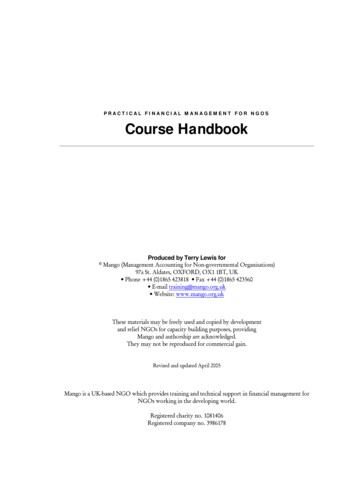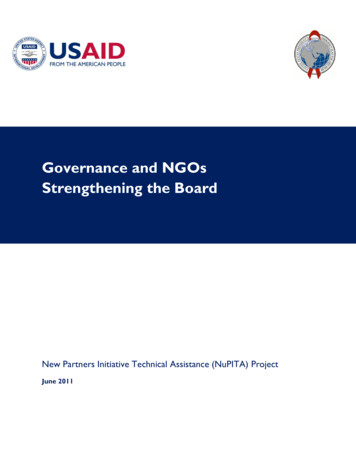
Transcription
Governance and NGOsStrengthening the BoardNew Partners Initiative Technical Assistance (NuPITA) ProjectJune 2011
The New Partners Initiative Technical Assistance (NuPITA) project is funded by the United States Agency forInternational Development (USAID) and implemented by John Snow, Inc. and Initiatives Inc. contract GHS-I-0007-00002-00.This document is made possible by the generous support of the American people through USAID. The contentsare the responsibility of John Snow, Inc. and do not necessarily reflect the views of USAID or the United StatesGovernment. June 2011 John Snow, Inc.NuPITAJohn Snow, Inc.44 Farnsworth StreetBoston, MA 02210-1211Phone: 617.482.9485www.jsi.com
ContentsNGO GOVERNANCE WORKSHOP FOR BOARDS OF DIRECTORS . iNGO GOVERNANCE OVERVIEW . iiWORKSHOP AGENDA . iiiWORKSHOP DESIGN . ivSESSION I: INTRODUCTIONS AND EXPECTATIONS . 1SESSION 2: PRINCIPLES OF GOVERNANCE AND BOARDS OF NGOS . 2HANDOUT 1: DEFINITIONS OF GOVERNANCE . 4HANDOUT 2: WHY DO NGOS AND CSOS NEED BOARDS OF DIRECTORS? . 5HANDOUT 3 . 6HANDOUT 4 . 7HANDOUT 5 . 8SESSION 3: A BALANCED BOARD . 9HANDOUT 1 . 11HANDOUT 2 . 12HANDOUT 3 . 13SESSION 4: BOARD STRUCTURES, ROLES, and PROCEDURES . 15HANDOUT 1 . 17HANDOUT 2 . 18HANDOUT 3 . 19HANDOUT 4 . 20HANDOUT 5 . 21HANDOUT 6 . 22SESSION 5: BOARD LEADERSHIP, DUTIES, and RESPONSIBILITES . 23HANDOUT 1 . 25
HANDOUT 2 . 26HANDOUT 3 . 27HANDOUT 4A . 28HANDOUT 4B . 29HANDOUT 5 . 30HANDOUT 6 . 31SESSION 6: BOARD MEMBERS LEADING CHANGE. 32HANDOUT 1 . 33
NGO GOVERNANCE WORKSHOP FOR BOARDS OFDIRECTORSPURPOSEThis workshop is designed to build the capacity of boards of directors and support them in developingand sharing models of good governance practice.GOALSTo support leaders for governance among members of boards of directorsTo develop the skills and knowledge needed to implement NGO governancePARTICIPANT PROFILEParticipants at the workshop will be board directors and chief executive officers of NGOs who wish tofurther build their capacity in areas such as:Providing leadership as board members of an NGOEstablishing and defending the organizational mission and valuesSupporting and supervising the organization’s chief executive officerProviding financial oversight and planningOverseeing and supporting strategic planningDeveloping sustainable resourcesManaging or overseeing internal controls and risk managementMonitoring the organization’s activities and portfolioPromoting and enhancing the organization’s imageReviewing the board of directors’ performanceMETHODOLOGYThe workshop’s experience-based activities are designed to promote full participation, mutualunderstanding, inclusive solutions, and shared responsibilities.DEFINITIONWe use the term “the board” to mean the organization’s governing body. In your organization it may becalled the board, the trustees, the management committee or some other name. It is the body withoverall responsibility for governing the organization, overseeing and controlling its management.i
NGO GOVERNANCE OVERVIEWSESSION 1: INTRODUCTIONS AND EXPECTATIONSSESSION 2: PRINCIPLES OF GOVERNANCE AND BOARDS OF NGOS Accountability, responsibility, transparency, and fairness The relationships between the board, management, and the stakeholdersSESSION 3: A BALANCED BOARD Composition of a balanced board A checks-and-balance systemSESSION 4: BOARD STRUCTURES, ROLES, AND PROCEDURES The board charter and by-laws The difference between managing and directing The role of the chairman, financial officer, and board secretary The role of the committees Managing an effective board meetingSESSION 5: BOARD LEADERSHIP, DUTIES, AND RESPONSIBILITIES Duties and liabilities Setting strategic priorities Financial oversight Overseeing, supporting management Advocating for and representing the organizationSESSION 6: BOARD MEMBERS LEADING CHANGE Board Progression Matrix Board Action Planii
WORKSHOP AGENDADAY ONE08:30 – 09:0009:00 – 10:0010:00 – 10:1510:15 – 13:0013:00 – 14:0014:00 – 15:3015:30 – 15:4514:45 – 17: 1517:15 – 17:30RegistrationSession: 1 Introductions and ExpectationsCoffee BreakSession: 2 Principles of Governance and Boards of NGOsLunchSession 3: A Balanced BoardTea BreakSession 4: Board Structures, Roles, and ProceduresWrap upDAY TWO09:00 – 10:3010:30 – 10:4510:45 – 13:0013:00 – 14:0014:00 – 15:3015:30 – 16:00Session 5: Board Leadership, Duties, and ResponsibilitiesCoffee BreakSession 5: Board Leadership, Duties, and Responsibilities, continuedLunchSession 6: Board Members Leading ChangeWorkshop Evaluation and ClosureThe materials covered in this package offer a full range of topics for board development. It is presentedin the agenda above as a two-day workshop. However, members of governing boards are seldom able todedicate even two days a year to board development. Trainers are advised to conduct a needsassessment with their clients and identify which topics in the package are of most interest. Oncesessions have been selected, the trainer can expand or contract them to meet the board’s priority needsin the timeframe that is being allocated. For this reason, the trainer’s notes – which can be shared withparticipants – have no time slots.The handouts in this package are the tip of the information iceberg. They provide trainers with focusand the workshop participants with organized, supplementary information. Trainers using this packageneed to be knowledgeable in matters pertaining to board governance, ready to add their own stories ofboard development and invite participants to share their experiences as members of governing bodies.iii
WORKSHOP DESIGNThe sessions are designed in a 4-step approach: Step 1 gives workshop participants opportunities to share/reflect on their own personalexperiences as members of boards. Step 2 gives the trainer the opportunity to discuss and share information with participants. Step 3 gives workshop participants opportunities to strategize and plan to deal with theproblems/issues/topics under discussion. Step 4 gives workshop participants opportunities to share the main messages of the session andthe steps they commit to take to improve the efficiency of their board.iv
SESSION I: INTRODUCTIONS AND EXPECTATIONSWelcome and opening remarksIntroduction of trainerIntroductions of participantsExpectations of participantsWorkshop goals and agendaWorkshop norms1
SESSION 2: PRINCIPLES OF GOVERNANCE AND BOARDSOF NGOSSESSION OBJECTIVES Define and explain the key principles and elements of good governance systems Explain how a governance framework works effectively within an organization Define the case for governance within an organizationSTEP 1Table groups discuss definitions of governance, choose one definition and in a plenary discussion sharetheir reasons for their choice. HANDOUT 1Trainer asks why does an organization need a board? HANDOUT 2STEP 2Trainer presents the following information asking participants to give examples of each of the principlesin action in the context of their board. HANDOUT 3ACCOUNTABILITYPRINCIPLES OF GOVERNANCETRANSPARENCYRESPONSIBILITYFAIRNESSSTRONG BOARD COMMITMENT TO GOVERNANCETrainer and participants discuss the chart below and clarify the difference between “agency” and“stewardship.” HANDOUT 4The Principle Actors in the Governance Systems of an NGOCLIENT COMMUNITIESMANAGERSTHE BOARDTrainer and participants discuss points of tension between the Board, management, stakeholders and influencesand how to overcome them. HANDOUT 5STEP 3Participants work in table groups to present a role play on marshaling arguments to convince a chairmanof a board who is reluctant to establish a culture of governance in the organization.STEP 4Participants Review objectivesShare take-aways from the session2
HANDOUTS FOR SESSION 2HANDOUT 1: DEFINITIONS OF GOVERNANCEHANDOUT 2: WHY DO NGOS AND CSOS NEED BOARDS OF DIRECTORS?HANDOUT 3: THE PRINCIPLES OF CORPORATE GOVERNANCEHANDOUT 4: THE PRINCIPLE ACTORS IN THE GOVERNANCE SYSTEM OF AN NGOHANDOUT 5: WHO ARE THE STAKEHOLDERS? WHAT ARE THE IFLUENCES?3
HANDOUT 1: DEFINITIONS OF GOVERNANCE1. Governance is concerned with processes, policies, procedures, systems and practices,both formal and informal, the manner in which they are applied and followed, therelationships that these processes create or determine, and the nature of theserelationships.-African Family Association, Kenya2. Governance is concerned with the ethical principles, values and practices that facilitateholding the balance between economic and social goals and between the individual andcommunal goals. The aim is to align as nearly as possible the interests of individuals,organizations and society within a framework of sound governance and common good.-African Union NEPAD3. Governance involves a set of relationships between an organization’s management, itsBoard and other stakeholders. Governance also provides the structure through whichthe objectives of the organization are set, and the means of attaining those objectivesand monitoring performance are determined.-Organization for Economic Cooperationand Development4. Governance means ‘leadership, sustainability and corporate citizenship.-The King III Report from South Africa4
HANDOUT 2: WHY DO NGOs AND CSOs NEED BOARDSOF DIRECTORS?1. Boards are often required by law.2. Boards provide oversight functions3. Boards promote the organization’s mission4. Boards help raise funds5
HANDOUT 3THE PRINCIPLES OF GOVERNANCEACCOUNTABILITY FAIRNESSTRANSPARENCYEnsure management isProtect stakeholdersProvide openaccountable to boardrightsleadershipEnsure board isaccountable tostakeholdersEnsure overallaccountability foractions and use ofresources to donors,legal authority,employeesTreat all stakeholdersequitablyProvide redress forviolationsEnsure timely,accurate disclosureon financial situation,performance,stewardship, andgovernanceRESPONSIBILITYRecognize stakeholders’rightsEncourage cooperationin meeting NGO goalsEnsure leadership iscapable, responsible,representative,conscious of itsobligationsEnsure effectiveness andefficiency in the use ofresources and in gettingresultsAdapted from: Corporate Governance Board Leadership Training Resources KitInternational Finance Corporation, World Bank Group.6
HANDOUT 4The Principle Actors in the Governance Systems of an NGOCLIENT COMMUNITIESClient communities provide socialClient communities advise theand human capital to managersBoardManagers act as agents forclient communitiesMANAGERSManagers report to the boardDirectors act as stewards forcommunitiesTHE BOARDThe board oversees managersGovernance issues/tensions arise from the roles of agency and stewardship. Agencyinvolves the transfer of capital from the beneficiaries to the control of the managers.Stewardship refers to the directors’ role as guardians of the NGO’s assets7
HANDOUT 5A GOVERNANCE SYSTEMWho are the otherstakeholders?Clients/participants in torsGovernmentWho are the primarystakeholders?The BoardManagementEmployees*What are the influences?Laws and regulationsMediaAccounting/audit standardsNGO codes of governanceNGO networks8
SESSION 3: A BALANCED BOARDSESSION OBJECTIVES Define a balanced board Identify the characteristics of a well-functioning checks-and-balance system Define the steps that boards can take to strengthen a system of checks-and-balanceSTEP 1Trainer facilitates table group discussion followed by plenary sharing Why do you serve on this board? What strengths do you bring to the table? How balanced is your board?STEP 2Trainer asks What are the characteristics of a balanced board? HANDOUT 1What’s a system of checks-and-balances? HANDOUT 2How do checks-and-balances operate in the context of an NGO board?Trainer presents the following information and discusses how power imbalances can diminish theeffectiveness of boards. HANDOUT 3What’s driving your board? Who’s got the power?PERSONALITYPEOPLEPERFORMANCEPOLICYSTEP 3Participants work in table groups on scenarios and present in plenary their solutions to the followingissues. HANDOUT 4 Lack of succession planning Lack of recruitment guidance Lack of renewal training opportunities Lack of annual board evaluationSTEP 4Participants Review learning objectivesShare take-aways from the sessionShare actions they will take as a result of the session9
HANDOUTS FOR SESSION 3HANDOUT 1: Definition of “team”How many people should be on a board?Director skills, experience, attributes for a balanced boardHANDOUT 2: A system of checks and balanceHANDOUT 3: What’s driving your board? Who’s got the power?HANDOUT 4: Scenarios10
HANDOUT 1A real team is a small number of good people with complimentary skills who are equally committed to acommon purpose clear performance goals and a joint approach for which they hold themselves mutuallyaccountable.-Laurance KuperHOW MANY PEOPLE SHOULD BE ON THE BOARD?This depends on the size of the organization. On average small to medium organizations have 5 to 7board members. Organizations should choose a board size that will enable them to: Hold productive, constructive discussionsMake prompt, rational decisionsEfficiently organize the work of its committees, if these are establishedEnsure that the organization operates effectivelyNote: Having an odd number of board members has been shown to keep the system of checks andbalances in good working order.DIRECTOR SKILLS, EXPERIENCE, ATTRIBUUTES FOR A BALANCED BOARD Financial expertise Relevant development experience Legal expertise Representatives of key stakeholders Honesty and integrity Gender distribution Age distribution11
HANDOUT 2A SYSTEM OF CHECKS AND BALANCES1. CORPORATE: Internal control mechanism that guards against fraud and errors due to omission.In a system with checks and balances, the authority to make a decision, and the associatedresponsibility to verify its proper execution, is distributed among different departments. Thesedepartments are kept logically and physically apart, and no one department can complete atransaction all on its own. For example, the purchasing department orders goods, the storesdepartment receives and compares them with the respective purchase orders, the qualityassurance department inspects and verifies their quality, the accounts department verifies theinvoice amount, and only then the comptroller authorizes the payment for the purchase. Thisprocess emphasizes interdependence without interference, and creates a data trail or paper trailfor auditing.2. GOVERNMENTAL: Extension of the separation of powers doctrine, under which each branch ofa government can (if necessary) counter the actions or decisions of the other branches. Thisarrangement ensures transparency, and prevents domination of the government by any branch.In the U. S. the branches of government are the executive, legislative and judicial.3.AN NGO BOARD? WHAT CHECKS AND BALANCES DOES YOUR BOARD HAVE? CAN YOUGIVE EXAMPLES?12
HANDOUT 3What’s driving your board? Who’s got the power?PERSONALITYPEOPLEFeaturesDriven by resultsStrong iconic leadershipUse passion to exert powerOften strong, task-focused chair and/or CEOFeaturesDriven by relationshipsFamily atmosphereUse relationships to exert powerOften highly creative and people-oriented chairand/or CEO"Trust me""Involve me"Benefits and challenges:Nimble, rapid decisionsRisk taking, innovativeLeader can alienateNo empowermentAlways changing, can overreachBenefits and challenges:Consensus-driven, teamLoyalty encouraged and rewardedResists "outsiders" ( non-family)Resists changeDifficulty setting priorities and taking riskGreatest fear: Power sharingGreatest fear: DivisionPERFORMANCEPOLICYFeatures:Driven by best practicesReplication of tasksUse reason and measures of performance toexert powerChair or CEO is often a peacemaker andconsensus builderFeatures:Driven by rules and policyBureaucraticUse rules to exert powerChair or CEO is often very analytical and precise"Show me"Benefits and challenges:Cautious and slow decision-making - traditionalapproachesClear, routine, focusTraditionalResistant to change, outsidersBenefits and challenges:Facts, benchmarks, results are keySystematicUndervalues people with divergent viewsNot as innovative as could beBenchmarking can be circularGreatest"Tell me"Greatest fear: Changing the systemfear: Taking risksAdapted from the Canadian Cooperative Association13
HANDOUT 4The following scenarios illustrate the difficulties that can arise when the board is thrown off balancebecause board members are entrenched; recruitment processes are not geared towards maintaining adiverse board; board members have no way of keeping up with a changing development landscape; orthe board does not evaluate its performance.SCENARIO 1The chairman of the board is also the founder of the organization. Thanks to her drive and commitmentthe organization has grown to its current size and strength. However, the chairman monopolizes alldecision-making and is constraining the pursuit of further growth.What should the board do?SCENARIO 2Several key members of the board recently retired because of illness, age or family pressure. The boardcannot reach consensus on the type of person it would like to recruit to replace them. Some see this asan opportunity to bring in a “new generation” with different ideas. Others would like to keep to a morefamiliar profile and not recruit “outsiders”.What should the board do to resolve this dilemma?SCENARIO 3Your organization recently applied for but lost a bid for a sizeable grant. The feedback your organizationreceived is that its approach lacks innovation and the capacity to deal with a changing environment. Asboard members you realize that you have been resting on your laurels and not kept up-to-date newtrends in development, nor have you been supporting the executive director’s effort to introduceprogrammatic innovation.What should the board do now?SCENARIO 4A key member of the board has threatened to resign unless the board puts in place an annual evaluationof its performance. This has caused consternation on the board. Some members believe that a formalevaluation process would illustrate a lack of trust in the board; some think it would be too stressful;some fear that they might subsequently be asked to leave the board.What should the board do?14
Session 4: Board Structures, Roles, and ProceduresSESSION OBJECTIVESDescribe the roles of chair, secretary, treasurer Explain the differences between managing and directing Describe the functions of board committees Explain the different roles of board members before, during, and after a board meetingSTEP 1Trainer presents the following chart and asks participants to complete it by listing what can be found intheir organization’s by-laws. In plenary participants share their experiences on the importance of wellfunctioning by-laws. HANDOUT 1Articles of Association/Articles of Incorporation/Charter/ConstitutionProvide the legal basis for the organizationSpecify the organization’s purposeDescribe the role, rights and responsibilities of the boardBy-laws supplements the articles ofWhat can be found in your organization’s by-laws?association and describes the compositionand procedural operations of the boardSTEP 2Trainer presents information and facilitates discussion on the following topics: Roles of chair, secretary, treasurer HANDOUT 2 Difference between managing and directing HANDOUT 2 Roles of committees: Executive – Finance/Audit – Nominations – Governance –Development – Public Relations – Programs HANDOUT 3 Managing an effective meeting: responsibilities before, during and after a board meeting.HANDOUTS 4 and 5STEP 3Role play – Divide participants into three small groups. Ask everyone to read the role play –HANDOUT6. Ask Group 1 to prepare one of their group to play the role of the chair; Group 2 to prepare one oftheir group to play the role of the executive director, and Group 3 to prepare one of their group toplay the role of the dissenting board member.STEP 4Participants Review learning objectivesShare take-aways from the sessionShare actions they will take as a result of the session15
HANDOUTS FOR SESSION 4HANDOUT 1: Articles of association and by-lawsHANDOUT 2: The roles of the chair, board secretary, and treasurerThe differences between managing and directingResponsibilities of the board of directors and management teamof the organizationHANDOUT 3: The roles of the committeesHANDOUT 4: A sound decision-making environmentHANDOUT 5: Roles, responsibilities before, during, and after a board meetingChallenges and solutions to preparing for, conducting and following upon effective board meetingsHANDOUT 6: Role play: Dissent or consensus?16
HANDOUT 1Articles of AssociationProvide the legal basis for theorganization, specify theorganization’s purpose describethe role, rights andresponsibilities of the boardLaw prescribes the form and content of articles of incorporation.Although requirements vary from country to country, typical itemsrequired in articles of incorporation for an NGO include: Name of the organization. Duration of the organization (usually perpetual). Purpose for which the organization is formed. Provision for conducting the internal affairs of theorganization. Names and address of the incorporators. Address of the initial registered office and name of theinitial registered agent of the organization. Provision for distribution of the assets of the organizationon dissolution.By-laws supplements thearticles of association anddescribes the composition andprocedural operations of theboardThese provisions vary from country to country but usually address: General assemblies Maximum and minimum number of board members The number required for a quorum Minimum number of meetings per year Terms and term limits of board members Appointments, powers and duties of directors and the CEO Procedures for removing a board member Conflict of interest policy Board liabilities How a special or emergency board meeting may be called How a committee may be created or dissolved What committees exist, how members are appointed andwhat powers if any Board proceedings Appointment, powers and duties of the board secretary Accounts and audit Special provisions associated with winding up theorganization17
HANDOUT 2Role of the chairLeads board to fulfill its responsibilities, sets strategic direction, plans and leads board meetings, plansand signs off on board agenda, structures board committees and reviews reports from committees,hires, fires, and supervises CEO, ensures board assessment, oversees the budget, acts as spokespersonfor the board.Role of the board secretaryAdvises the chair on the agenda, sets annual calendar for board meetings, sends packets of informationto board members prior to meetings, keeps minutes of meetings and records of board decisions,arranges logistics for board meetings.Role of the treasurerTakes lead responsibility for overseeing financial affairs of the organization, presents and explainsbudgets and financial reports to board, leads finance or audit committee.The difference between directing and managingDIRECTINGMANAGINGCollective decision-makingIndividual decision-makingFulfill duties and responsibilities to organization andFulfill duties and responsibilities specific tostakeholdersdepartmentDevelop and/or approve vision and strategyDevelop and implement vision and strategyApprove, abide by ethics codeAbide by ethics codeSignoff of financial statements, annual reports etc.Prepare financial statements, annual reportsetc.Responsibilities of the board of directors andBoard responsibilitiesDefine the organization’s vision and missionSet strategic direction, approve strategic plan andbusiness planReview and approve policies developed bymanagementHire, evaluate, fire (if necessary) CEOProvide financial oversightReview and approve budgetLead in fund-raisingRepresents the organization publicallymanagement team of the organizationManagement team responsibilitiesDisseminate vision and missionDevelop strategic plan and business planDevelop work plans based on strategic planDevelop policies and manuals (e. g. HRM,ethics) for board consideration and approvalProvide board with financial reportsDevelop budgetAssist in fund-raising, develop resourcemobilization planRepresents the organization publically18
HANDOUT 3Roles of Board CommitteesExecutive Committee: Usually made up of chair, vice-chair, secretary, and treasurer. Helps makedecisions and solve problems between scheduled board meetings.Finance or Audit Committee: Composed of treasurer, CEO, and other board members withfinancial skills (accountants or auditors). Oversees budgets, advises board on approval of overall budgetand capital expenditures, ensures that independent audits take place.Risk Committee: Sometimes combined with audit committee. Analyzes risk and contributes thisanalysis to the development and monitoring of the organization’s strategic plan.Nominations Committee: Sometimes combined with governance committee. Develops criteria forrecruitment of new board members, leads recruitment of new members, develops orientation packagefor new members.Governance Committee: May include people with legal backgrounds. Leads organization of boarddevelopment, ethics policy, and board evaluation.Program Committee: Reviews current programs, ensures that they are in line with organization’sstrategic directions, reviews M&E of current programs, reviews proposed programs.Ad-hoc Committees:Can be formed to deal with specific needs such as recruitment of a new CEO or organization of afund-raising event.19
HANDOUT 4Patrick Lencioni, author of The Five Dysfunctions of a Team and Overcoming the Five Dysfunctions of a Team,describes five dysfunctions of a team and proposes the means to overcome these dysfunctions:1. Overcome the absence of trust – members of great teams trust one another on afundamental, emotional level, and they are comfortable being vulnerable with each other abouttheir weaknesses, mistakes, fears and behaviors. They get to a point where they can becompletely open with one another, without filters.2. Overcome the fear of conflict – Teams that trust one another are not afraid to engage inpassionate dialogue around issues and decisions t
legal authority, employees Protect stakeholders rights Treat all stakeholders equitably Provide redress for violations Provide open leadership Ensure timely, accurate disclosure on financial situation, performance, stewardship, and governance Recognize stakeholders' rights Encourage cooperation in meeting NGO goals Ensure leadership is



